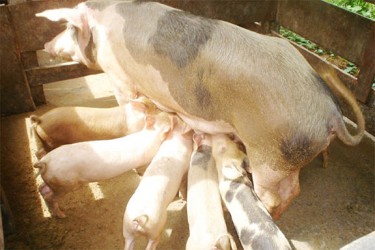Wresting control of the local pork market from profiteering middle men and raising production standards in the sector are among the primary objectives of the recently established Guyana Swine Producers Cooperative Society (GSPCS).
Stabroek Business has learnt, during an interview earlier this week with key executive members of the society, that pig farmers have grown frustrated over the fact that while feed and other inputs continue to increase in price, middlemen are constantly on the lookout for pig rearers from whom they can acquire pork at “rock bottom” prices only to more than double the prices on the retail market.
Compton Hinds, a committee member of the GSPCS told Stabroek Business this week that if the swine producers grouping is to make a positive impact on the fortunes of local pig farmers it must seek to better position to secure the best prices offered on the market. Hinds explained the so-called hog cycle which creates peaks and troughs in the supply of pork and enables the middlemen to purchase pigs at significantly lower than market prices and make “a killing” at the other end. Hinds said it was not unusual to find that while middlemen are able to secure pork at relatively low prices “at the farm gate” the price of pork at the retail end remained relatively high.

member Compton Hinds
When Stabroek Business monitored food prices at the La Penitence Sunday Market, pork was being sold at $500 per pound. A West Berbice pig rearer said earlier this week however, that just a few weeks ago a middleman was offering “less than half of that price” for live pigs.
Sources close to the pig industry have told this newspaper that the middlemen are “part of a cartel that includes other people in the business sector” who are determined “to keep pork prices at the farm gate” low.
Chairman of the GSPCS Eric Anderson said that positioning the farmers to secure greater financial reward from the industry would require “cutting out the middle men,” an objective which he said was part of the current pursuits of the society.
Stabroek Business has also spoken to several pig farmers in Region Four who concur on the negative impact of middlemen on producers’ share of the takings in the industry. “Because we do not always have a really reliable market for our pigs we must sometimes sell at less than cost of production,” one farmer said. Small farmers on the East Coast and West Coast Berbice are under pressure to sell at prices that are below the cost of production since, as another farmer put it, “the longer you hold the pig, the more it costs you to keep it.”
Hinds, meanwhile, said that the GSPCS since its establishment in April this year, has generated a membership of around 40 pig farmers. It is in the process of undertaking a “limited audit” of the sector. The key objectives of the audit are to seek to determine the size of the industry and the extent of the breeding and other resources as well as to mobilise the country’s pig farmers under a single umbrella.
Executive members of the GSPCS believe that the weakness of the country’s largely privately-owned, pig-rearing industry derives largely from the fact that the sector comprises significant numbers of small farmers who are unable to negotiate collectively. Hinds explained that a similar situation exists in the feed industry where much of the distribution of rice bran, a key food staple in the sector is controlled by middlemen who are in a position to manipulate prices. Hinds said that rice bran prices can range from $400 to $1,000 per bag.
While the society says that in the longer term it proposes to seek to broaden the base of the industry to enable a return to the production of pork products, including ham and bacon, Anderson said that in the short-term completing the audit of the sector and determining the extent of resources available was a priority. He said he believed that one of the short-term pursuits would have to be the acquisition of enhanced breeding stock. Suriname could be a likely location for the acquisition of such stock.

Asked about the prospects for reviving the local pork products industry in order to reduce the periodic glut of fresh pork on the market, Hinds disclosed that the society had earlier undertaken an unsuccessful attempt to garner funds for the creation of a modest pork products factory and that it continued to be open to investment proposals for the value-added sub sector.
Anderson says, however, that while the creation of a value-added facility was important for the growth of the sector, the society’s more immediate concern was with mobilising pig farmers across the country in order to enhance their collective influence in the sector. Hinds said, meanwhile, that raising breeding standards, addressing health concerns, garnering finances for investment in key industry projects and expanding pork markets were also among the objectives of the society.
GSPCS Secretary Owen McGarrell concurred that the priorities of the organisation would have to be to help create a strong and influential group of pig farmers across the country and to open more avenues through which pig-breeding could become a profitable business pursuit.





